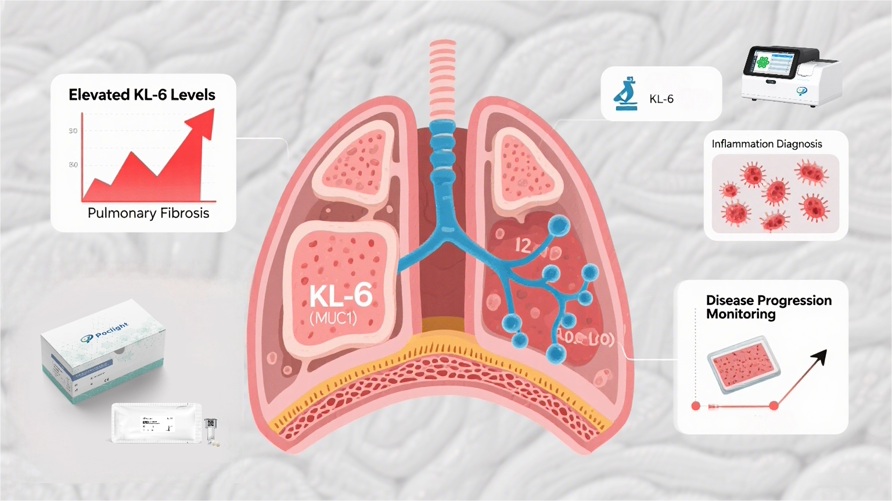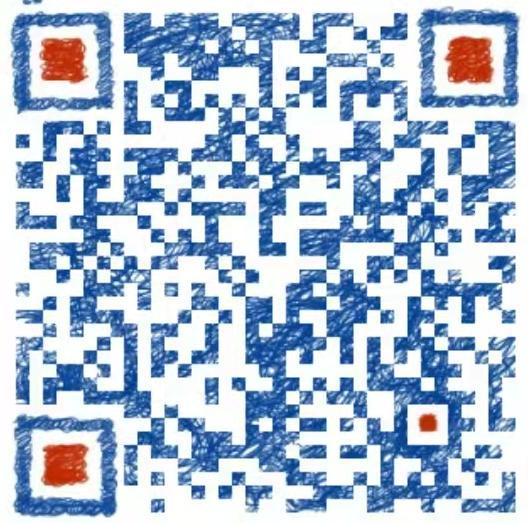1.KL-6詶й®УгВљгГ™гГ•гГЉгВЈгГІгГ≥
KL-6пЉИгВѓгГђгГЦгВєгГїгГХгВ©гГ≥гГїгГЗгГ≥гГїгГЂгГ≥гВ≤гГ≥-6пЉЙ
гВҐгГГгВїгВ§гВ≠гГГгГИ
MUC1з≥ЦгВњгГ≥гГСгВѓи≥™гГХгВ°гГЯгГ™гГЉгБЂе±ЮгБЩгВЛйЂШеИЖе≠РгГ†гГБгГ≥гБІгБВгВКгАБдЄїгБЂIIеЮЛиВЇиГЮдЄКзЪЃзі∞иГЮгБЛгВЙеИЖж≥МгБХгВМгВЛгАВиЗ®еЇКз†Фз©ґгБІгБѓгАБ
KL-6гГђгГЩгГЂгБЃдЄКжШЗ
иВЇзЈЪзґ≠зЧЗгБ®еѓЖжО•гБЂзЫЄйЦҐгБЧгБ¶гБДгВЛгАВ
зВОзЧЗ
гВ§гВ™гГ≥
и®ЇжЦ≠
гАБгБКгВИгБ≥зЧЕж∞ЧгБЃйА≤и°М
гАВ

2. KL-6гБЂйЦҐйА£гБЩгВЛзЦЊжВ£
KL-6гБѓгАБеСЉеРЄеЩ®зЦЊжВ£гАБзЙєгБЂILDгБЃйЗНи¶БгБ™и°АжЄЕгГРгВ§гВ™гГЮгГЉгВЂгГЉгБІгБЩгАВKL-6еА§гБЃдЄКжШЗгБѓгАБдї•дЄЛгБЃе†іеРИгБЂгВИгБПи¶ЛгВЙгВМгБЊгБЩгАВ
-
зЙєзЩЇжАІиВЇзЈЪзґ≠зЧЗпЉИIPFпЉЙ
-
йЭЮзЙєзХ∞жАІйЦУи≥™жАІиВЇзВОпЉИNSIPпЉЙ
-
иЗ™еЈ±еЕНзЦЂзЦЊжВ£йЦҐйА£ILDпЉИдЊЛпЉЪеЕ®иЇЂжАІеЉЈзЪЃзЧЗгАБгВЈгВІгГЉгВ∞гГђгГ≥зЧЗеАЩзЊ§гАБзЪЃиЖЪз≠ЛзВОпЉЙ
-
иЦђеЙ§и™ШзЩЇжАІгБЊгБЯгБѓжФЊе∞ДзЈЪи™ШзЩЇжАІгБЃиВЇйЪЬеЃ≥
-
йЗНеЇ¶гБЃжДЯжЯУзЧЗ/гВ¶гВ§гГЂгВєжАІиВЇзВОпЉИдЊЛпЉЪCOVID-19пЉЙ
-
жА•жАІеСЉеРЄз™ЃињЂзЧЗеАЩзЊ§пЉИARDSпЉЙ
гБУгВМгВЙгБЃзЧЗзКґгБѓгБЩгБєгБ¶иВЇиГЮдЄКзЪЃгБЃжРНеВЈгБЂйЦҐйА£гБЧгБ¶гБДгБЊгБЩгАВKL-6ж§ЬжЯїгБѓгАБйЭЮдЊµи•≤жАІгБІзє∞гВКињФгБЧжЄђеЃЪеПѓиГљгБ™еЃЪйЗПгГҐгГЛгВњгГ™гГ≥гВ∞гГДгГЉгГЂгБІгБЩгАВ
3. ж≤їзЩВгГҐгГЛгВњгГ™гГ≥гВ∞гБЃгГЭгВ§гГ≥гГИ
иЗ®еЇКзЃ°зРЖгБЂгБКгБДгБ¶гАБKL-6 гБѓжђ°гБЃгВИгБЖгБ™зВєгБІдЊ°еА§гБМгБВгВКгБЊгБЩгАВ
-
гГЩгГЉгВєгГ©гВ§гГ≥и©ХдЊ° вАУ гГХгВ©гГ≠гГЉгВҐгГГгГЧгБІгБЃжѓФиЉГгБЃгБЯгВБгБЃи®ЇжЦ≠жЩВгБЃеИЭжЬЯжЄђеЃЪ
-
ж≤їзЩВињљиЈ° вАУ ж≤їзЩВеЊМ1пљЮ3гГґжЬИгБІжФєеЦДгБЊгБЯгБѓжВ™еМЦгВТи©ХдЊ°гБЩгВЛгБЯгВБгБЃеЖНж§ЬжЯї
-
еЖНзЩЇдЇИжЄђ вАУ KL-6гБЃеЖНдЄКжШЗгБѓеЖНзЩЇгБЊгБЯгБѓеРИдљµзЧЗгВТз§ЇеФЖгБЩгВЛеПѓиГљжАІгБМгБВгВЛ
-
гГЮгГЂгГБгГЮгГЉгВЂгГЉгБЃзµДгБњеРИгВПгБЫ вАУ KL-6гБ®SP-DгАБLDHгАБгВ§гГ°гГЉгВЄгГ≥гВ∞гВТзµДгБњеРИгВПгБЫгБ¶з≤ЊеЇ¶гВТеРСдЄК
4. дЄЦзХМгБЃKL-6ж§ЬжЯїеЄВе†іи¶Пж®°гБ®дЄїи¶БгГЦгГ©гГ≥гГЙгБЃжѓФиЉГ
пЉИпЉСпЉЙдЄЦзХМеЄВе†іи¶Пж®°пЉИжЪЂеЃЪжО®и®ИпЉЙ
вС†жЧ•жЬђ вАУ жЬАе§ІгБЃеЄВе†іпЉЪKL-6гБѓгАБжЧ•жЬђгБЂгБКгБДгБ¶йЦУи≥™жАІиВЇзЦЊжВ£пЉИILDпЉЙгБЃи®ЇжЦ≠гБКгВИгБ≥гГҐгГЛгВњгГ™гГ≥гВ∞гБЂеЇГгБПдљњзФ®гБХгВМгБ¶гБКгВКгАБеЫљж∞СеБ•еЇЈдњЭйЩЇгБЃеѓЊи±°гБ®гБ™гБ£гБ¶гБДгБЊгБЩгАВеєійЦУж§ЬжЯїдїґжХ∞гБѓжХ∞еНБдЄЗдїґгБЛгВЙ100дЄЗдїґгВТиґЕгБИгВЛгБ®и¶ЛиЊЉгБЊгВМгБЊгБЩгАВ
вС°жђІз±≥пЉЪKL-6гБѓдЄїгБЂз†Фз©ґзЫЃзЪДгАБгБЊгБЯгБѓи£ЬеК©зЪДгБ™и®ЇжЦ≠гГРгВ§гВ™гГЮгГЉгВЂгГЉгБ®гБЧгБ¶дљњзФ®гБХгВМгБ¶гБДгБЊгБЩгАВжЧ•еЄЄи®ЇзЩВгБІгБѓгБЊгБ†еЇГгБПжО°зФ®гБХгВМгБ¶гБДгБЊгБЫгВУгБМгАБеЄВе†ігБѓжИРйХЈжЃµйЪОгБЂгБВгВКгБЊгБЩгАВ
вСҐCOVID-19гБЃељ±йЯњпЉЪгГСгГ≥гГЗгГЯгГГгВѓгБЂгВИгВКгАБKL-6гАБзЙєгБЂеСЉеРЄеЩ®зЦЊжВ£гБЃгГҐгГЛгВњгГ™гГ≥гВ∞гБЂгБКгБСгВЛKL-6гБЃдЄЦзХМзЪДгБ™и™НзЯ•еЇ¶гБМйЂШгБЊгВКгБЊгБЧгБЯгАВдїКеЊМгАБењЬзФ®гВЈгГКгГ™гВ™гБѓгБХгВЙгБЂжЛ°е§ІгБЩгВЛеПѓиГљжАІгБМгБВгВКгБЊгБЩгАВ
пЉИ2пЉЙдЄїи¶БгГЦгГ©гГ≥гГЙгБ®и£љеУБгБЃжѓФиЉГ
|
гГЦгГ©гГ≥гГЙ / гГЧгГ©гГГгГИгГХгВ©гГЉгГ†
|
ж§ЬеЗЇжЦєж≥Х
|
и£љеУБгБЃзЙєеЊі
|
еУБи≥™зЃ°зРЖгБ®дЊ°ж†Љ*
|
|
еѓМе£ЂгГђгГУгВ™
|
гВѓгГђгВ§гВҐ
|
йЂШжДЯеЇ¶гАБйЂШгВєгГЂгГЉгГЧгГГгГИ
|
иЗ™еЛХQC; $$$ (йЂШ)
|
|
гВ®гГЉгВґгВ§/гВ®гГЉгГЗгВ£гВҐ
|
гВ®гВѓгГ™гВҐ
|
иЗ®еЇКгВ∞гГђгГЉгГЙгБЃеЃЙеЃЪжАІ
|
зЧЕйЩҐгБЃж§ЬжЯїеЃ§; $$$
|
|
гГРгВ§гВ™гГЩгГ≥гГАгГЉ
|
ELISA / гГ©гГЖгГГгВѓгВє
|
гВЈгГ≥гГЧгГЂгАБдљОгВ≥гВєгГИ
|
зіД630гГЙгГЂ / 96гВ¶гВІгГЂ
|
|
MyBioSource / гВѓгГ™гВ®гВ§гГЖгВ£гГЦи®ЇжЦ≠
|
ELISA
|
и§ЗжХ∞гГЦгГ©гГ≥гГЙгАБз†Фз©ґзФ®
|
вВђ500пљЮ600 / 96гГЖгВєгГИ
|
|
гГЭгВѓгГ©гВ§гГИ
|
еЭЗи≥™CLIA
|
гВ≥гГЉгГЂгГЙгГБгВІгГЉгГ≥гБ™гБЧгАБгГЭгГЉгВњгГЦгГЂгАБTAT3пљЮ15еИЖгАБ
18гБЛжЬИйЦУгБЃRT;
|
жЬАе∞Пж≥®жЦЗжХ∞йЗПгБЃи©¶иЦђи≥ЉеЕ•гБІQCгБМзД°жЦЩ
|
*дЊ°ж†Љ: $ = дљОгАБ$$ = дЄ≠гАБ$$$ = йЂШ
5. ж≠£зҐЇ
KL-6
еМЦе≠¶зЩЇеЕЙеЕНзЦЂжЄђеЃЪпЉИCLIAпЉЙгБЂгВИгВЛжЄђеЃЪ
ELISA гБ®жѓФиЉГгБЩгВЛгБ®гАБCLIA гБѓ KL-6 ж§ЬеЗЇгБЂгБКгБДгБ¶жШОгВЙгБЛгБ™еИ©зВєгБМгБВгВКгБЊгБЩгАВ
CLIA гБѓгАБеЕНзЦЂеПНењЬгБ®еМЦе≠¶зЩЇеЕЙдњ°еПЈж§ЬеЗЇгВТзµДгБњеРИгВПгБЫгБЯжКАи°УгБІгАБKL-6 гБ™гБ©гБЃдљОжњГеЇ¶гГРгВ§гВ™гГЮгГЉгВЂгГЉгБЃйЂШжДЯеЇ¶еЃЪйЗПжЄђеЃЪгБЂйБ©гБЧгБ¶гБДгБЊгБЩгАВ
гГЖгВєгГИгГѓгГЉгВѓгГХгГ≠гГЉ:
-
жКЧеОЯ-жКЧдљУзµРеРИ вАУ KL-6гБѓеЫЇеЃЪеМЦгБХгВМгБЯдЄАжђ°жКЧдљУгБЂзµРеРИгБЩгВЛ
-
гВЈгВ∞гГКгГЂеҐЧеєЕ вАУ ж®Щи≠ШгБХгВМгБЯдЇМжђ°жКЧдљУгБМгВµгГ≥гГЙгВ§гГГгГБи§ЗеРИдљУгВТ嚥жИРгБЩгВЛ
-
еМЦе≠¶зЩЇеЕЙеПНењЬ - ж®Щи≠ШгБМеЯЇи≥™гВТиІ¶е™ТгБЧгБ¶еЕЙгВТзЩЇгБЩгВЛ
-
дњ°еПЈж§ЬеЗЇгБ®и®ИзЃЧ - еЕЙгБЃеЉЈеЇ¶гБѓKL-6жњГеЇ¶гБЂжѓФдЊЛгБЧгБЊгБЩ
6. еЕЄеЮЛзЪДгБ™гВ±гГЉгВє
зЧЗдЊЛпЉЪеЕ®иЇЂжАІеЉЈзЪЃзЧЗгБЃжВ£иАЕгБѓгАБи®ЇжЦ≠жЩВгБЂKL-6еА§гБМ1800 U/mLпЉИжЬЙжДПгБЂйЂШеА§пЉЙгБІгБВгБ£гБЯгАВ3гГґжЬИйЦУгБЃеЕНзЦЂжКСеИґзЩВж≥ХеЊМгАБеА§гБѓ950 U/mLгБЊгБІдљОдЄЛгБЧгАБзФїеГПж§ЬжЯїгБІгБѓзЈЪзґ≠еМЦзЧЕе§ЙгБЃзЄЃе∞ПгБМи™НгВБгВЙгВМгАБеСЉеРЄеЫ∞йЫ£зЧЗзКґгВВжФєеЦДгБЧгБЯгАВ
жіЮеѓЯ: KL-6 гБѓзЧЕж∞ЧгБЃж§ЬеЗЇгБЂељєзЂЛгБ§гБ†гБСгБІгБ™гБПгАБж≤їзЩВеПНењЬгВТеЃЪйЗПеМЦгБЧгАБеМїеЄЂгБЂж≤їзЩВи®ИзФїгВТи™њжХігБЩгВЛгБЯгВБгБЃи®ЉжЛ†гВТжПРдЊЫгБЧгБЊгБЩгАВ
7. Poclight C5000гБЃињЕйАЯж§ЬжЯїгБЃеИ©зВє
гГЭгГГгВѓгГ©гВ§гГИC5000
POCT CLIAеИЖжЮРи£ЕзљЃ
KL-6 ж§ЬжЯїгБЂгБѓгБДгБПгБ§гБЛгБЃзЂґдЇЙдЄКгБЃеИ©зВєгБМгБВгВКгБЊгБЩгАВ
-
гВ≥гГЉгГЂгГЙгГБгВІгГЉгГ≥詶иЦђгБЃењЕи¶БгБМгБ™гБДгБЯгВБгАБиЉЄйАБгБ®дњЭзЃ°гБМеЃєжШУгБЂгБ™гВКгАБзД°йІДгБМеЙКжЄЫгБХгВМгБЊгБЩгАВ
-
гГЭгГЉгВњгГЦгГЂгБІгВ≥гГ≥гГСгВѓгГИ - гГЧгГ©гВ§гГЮгГ™зЧЕйЩҐгАБи®ЇзЩВжЙАгАБзІїеЛХеЮЛеМїзЩВгГ¶гГЛгГГгГИгБЂйБ©гБЧгБ¶гБДгБЊгБЩ
-
з∞°еНШгБ™жУНдљЬ - 6гВєгГЖгГГгГЧгБІгГЖгВєгГИгВТеЃМдЇЖгБЧгАБ5еИЖдї•еЖЕгБЂзµРжЮЬгБМеЊЧгВЙгВМгБЊгБЩ

-
гГЮгГЂгГБгВҐгГГгВїгВ§гГЧгГ©гГГгГИгГХгВ©гГЉгГ† вАУ KL-6гБ®дїЦгБЃзВОзЧЗгГЮгГЉгВЂгГЉгВТеРМгБШгГЗгГРгВ§гВєгБІеЃЯи°М
-
йЂШз≤ЊеЇ¶гБ™зµРжЮЬ - е§ІеЮЛгБЃеЕ®иЗ™еЛХгГЧгГ©гГГгГИгГХгВ©гГЉгГ†гБЂеМєжХµгБЩгВЛCLIAжДЯеЇ¶
-
гВ™гГ≥гГЗгГЮгГ≥гГЙж§ЬжЯї - зЈКжА•жЩВгВДеЕ•йЩҐзЧЕж£ЯгБЃгГЩгГГгГЙгВµгВ§гГЙгБІгБЃдљњзФ®гБЂжЬАйБ©

 English
English fran√Іais
fran√Іais —А—Г—Б—Б–Ї–Є–є
—А—Г—Б—Б–Ї–Є–є espa√±ol
español português
portugu√™s ЎІўДЎєЎ±Ў®ўКЎ©
ЎІўДЎєЎ±Ў®ўКЎ© жЧ•жЬђи™Ю
жЧ•жЬђи™Ю T√Љrk√Іe
T√Љrk√Іe а§єа§ња§В৶а•А
а§єа§ња§В৶а•А Indonesia
Indonesia 








 IPv6гГНгГГгГИгГѓгГЉгВѓгБМгВµгГЭгГЉгГИгБХгВМгБ¶гБДгБЊгБЩ |
IPv6гГНгГГгГИгГѓгГЉгВѓгБМгВµгГЭгГЉгГИгБХгВМгБ¶гБДгБЊгБЩ | 